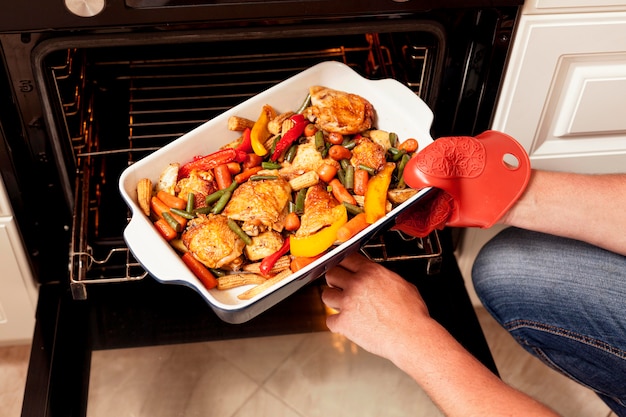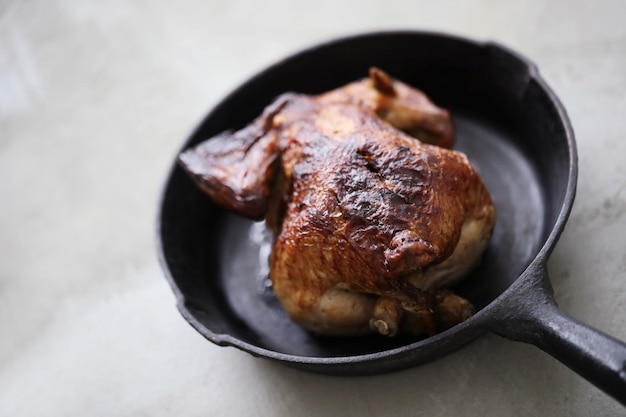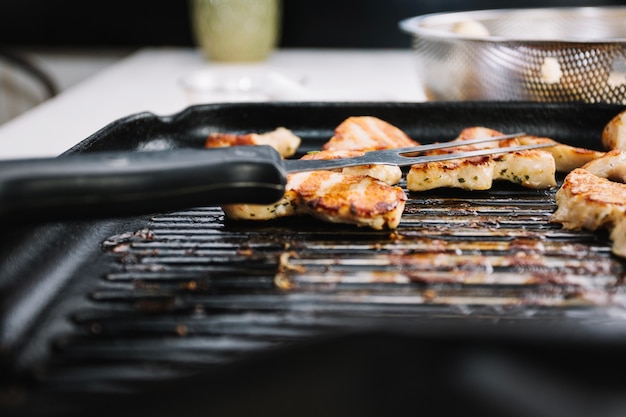I confess, I used to be a bit intimidated by lamb chops. They seemed like something you'd only find on fancy restaurant menus, requiring some kind of culinary wizardry that I, a humble home cook, couldn't possibly achieve. But then I realized, lamb chops are just meat, and I’m pretty good at cooking meat. So, I took a deep breath, gathered my courage, and decided to tackle these little guys head-on. It was a revelation! Turns out, perfect lamb chops are not some culinary mystery reserved for Michelin-starred chefs – they are totally achievable in your own kitchen.
This isn't just a recipe, though. This is a journey, a journey of discovery, of mastering a new technique, and of discovering the sheer joy of a perfectly cooked lamb chop. So, grab your apron, get your pan sizzling, and let's embark on this delicious adventure together.
(Part 1) Choosing the Right Lamb Chops

The first step in any cooking quest is getting your ingredients right. Lamb chops are no exception. Now, I'm not saying you need to be a butcher to pick the perfect chops, but there are a few things to keep in mind.
The Cut
You've got a few options here, each with its own personality and quirks:
- Rib Chops: These are the classic choice, renowned for their rich, full flavour and good amount of fat. Think of them as the rockstars of the lamb chop world. They're generally considered the "best" but can be a bit pricey, so they're a special occasion treat.
- Loin Chops: These are leaner than rib chops, with a slightly milder flavour. They're a good option if you're watching your fat intake or prefer a lighter taste. Think of them as the versatile, crowd-pleasing members of the lamb chop family.
- Frenched Chops: These are rib chops with the bone exposed, giving them a more elegant look. They're a bit more work to prepare (you need to trim the bone and make it pretty) but they're worth the effort for a fancy dinner party. Think of them as the glamorous, show-stopping stars of the lamb chop world.
Personally, I'm a sucker for rib chops. That juicy fat just adds so much flavour, and they have a satisfyingly meaty texture. But ultimately, the choice is yours! You can even mix and match if you're feeling adventurous.
The Quality
When it comes to lamb, quality really matters. You want to be sure you're getting the best possible meat, and that means knowing what to look for. Here's what you should be aiming for:
- Bright Red Colour: Good lamb should be a vibrant, bright red colour. Avoid chops that are pale or have a brownish tinge.
- Good Marbling: Look for chops that have a good amount of marbling – those white streaks of fat that run through the meat. Marbling is what adds flavour and tenderness.
- No Strong Odour: Fresh lamb should have a mild, pleasant aroma. If it has a strong, off-putting odour, it's probably not fresh and should be avoided.
I've learned from experience that a good butcher is your best friend here. They'll know their lamb, and they can usually give you some great advice on what to look for. Plus, they can even chop them up to your preferred thickness, which is a huge time-saver!
(Part 2) Preparing the Lamb Chops

Now that you've got your chops, it's time to get them ready for the pan. This part is actually quite simple, but it's important to do it right, to set your lamb up for success.
Trim the Fat
First, you'll want to trim any excess fat from the chops. This is about creating a balanced flavour profile, not about removing all the fat. You want to remove the thick, unsightly chunks, but leave a nice layer of fat around the edges – it's what will render down and baste the lamb as it cooks, adding moisture and flavour.
Seasoning
Now comes the fun part: seasoning. This is where you can really get creative and add your own personal touch. There are endless possibilities here, but I'm a big fan of a simple salt and pepper rub. The salt helps to draw out moisture from the meat and enhance the flavour, while the pepper adds a bit of heat and complexity.
You can also add herbs like rosemary, thyme, or oregano, or spices like cumin or paprika. Experiment with different combinations to find what you like best.
A little tip I picked up from my granddad is to let the lamb sit at room temperature for about 30 minutes before cooking. This helps it to cook more evenly and also enhances the flavour. The meat will warm up to room temperature and cook more uniformly throughout, rather than having a cold center.
(Part 3) Getting Your Pan Sizzling

This is where the magic happens. You need a pan that can hold the heat and distribute it evenly, and that means a cast iron pan is your best bet. This is the workhorse of the kitchen, capable of handling intense heat without warping or losing its shape. Cast iron is also known for its amazing heat retention, so it will keep your lamb chops cooking evenly and consistently.
Preheating
Preheat your pan over high heat for at least 5 minutes. You want it smoking hot – this is what gives those delicious sear marks and keeps the lamb juicy and flavorful. If you don't have a cast iron pan, a heavy-bottomed stainless steel pan will also work well. Just make sure it's preheated for at least 5 minutes so it's nice and hot.
Oil
Once your pan is screaming hot, add a tablespoon or two of oil. I prefer olive oil, but any high-heat oil will do, such as avocado oil or grapeseed oil.
(Part 4) Cooking the Lamb Chops
Now for the moment of truth! This is where your patience (and your pan's heat) will be tested.
Searing
Carefully place the lamb chops in the hot pan, making sure not to overcrowd them. Overcrowding the pan will cause the temperature to drop, leading to uneven cooking. You'll want to cook the chops in batches if necessary. Let them sear for 2-3 minutes per side, without moving them, until you have a beautiful, golden-brown crust. You'll hear that satisfying sizzle as the lamb hits the pan, and that's your cue to leave it be. Resist the urge to peek! Just let it cook undisturbed.
Flipping
After you've seared one side, carefully flip the chops and sear the other side for the same amount of time. Use tongs to flip the chops, as a spatula can tear the meat. Again, let them cook undisturbed until you have a nice, even crust.
Reducing Heat
Once you've seared both sides, you can reduce the heat to medium. Now, you've got a few options:
- Continue searing: If you like your lamb chops well-done, you can keep cooking them over medium heat for another few minutes, turning them every minute or so until they reach your desired level of doneness. The sear marks will deepen and the meat will become more firm.
- Finish in the oven: If you prefer your lamb chops medium-rare or medium, transfer them to a preheated oven at 350°F (175°C) for 5-10 minutes. This will allow the lamb to cook more evenly and gently, while still keeping the center juicy.
(Part 5) Checking for Doneness
The key to perfect lamb chops is knowing when to stop cooking them. You want them to be cooked to your liking, but you don't want to overcook them. Overcooked lamb chops will be dry and tough, and no one wants that.
You can use a meat thermometer to check for doneness, but if you're feeling adventurous (and trust me, you'll get the hang of it), you can check by pressing on the lamb.
Temperature Chart
Here's a handy table to guide you, showing the internal temperatures for different levels of doneness:
| Doneness | Internal Temperature (°F) | Internal Temperature (°C) |
|---|---|---|
| Rare | 125-130 | 52-54 |
| Medium-Rare | 130-135 | 54-57 |
| Medium | 135-140 | 57-60 |
| Medium-Well | 140-145 | 60-63 |
| Well-Done | 145 | 63 |
The Finger Test
If you don't have a thermometer, you can use the finger test. Here's how:
- Press on the thickest part of the lamb chop. If it feels firm and springs back, it's rare. The meat will be soft and red in the center.
- If it feels slightly firmer and has a little give, it's medium-rare. The meat will be pink in the center.
- If it feels firm and doesn't spring back, it's medium. The meat will be slightly pink in the center.
- If it feels very firm and doesn't give at all, it's well-done. The meat will be brown throughout.
Remember, it's better to err on the side of undercooked than overcooked. Lamb chops are best enjoyed medium-rare or medium, as they'll be tender and juicy. If you prefer them well-done, you can cook them a bit longer, but be warned, they might be a bit dry.
(Part 6) Resting the Lamb Chops
Once the lamb chops are cooked to your liking, take them off the heat and let them rest for 5-10 minutes. This is a crucial step! This will allow the juices to redistribute throughout the meat, resulting in a more tender and flavorful chop. When you cook meat, the juices tend to concentrate in the center. Resting allows those juices to flow back out to the edges, making for a more evenly moist and flavorful chop.
While the chops are resting, you can make a quick pan sauce. This is a simple but delicious way to add another layer of flavor to your lamb chops.
(Part 7) Making a Pan Sauce
This is the finishing touch that elevates your lamb chops from good to phenomenal. You've already got the perfect base in your pan – the delicious fond (the browned bits of lamb and oil) – so you don't need much else. This is where the flavor of the entire cooking process is concentrated, so we're going to make good use of it.
Deglazing the Pan
Pour a tablespoon or two of wine or broth into the hot pan and scrape up all the delicious fond. Bring it to a simmer and let it cook for a minute or two, until the sauce thickens. The wine or broth will loosen the fond, creating a flavorful base for your sauce.
Adding Flavor
To add a touch of extra flavor, you can add a knob of butter, a squeeze of lemon juice, or a handful of chopped herbs. The butter will add richness and shine, the lemon juice will add a bright, citrusy tang, and the herbs will add a fresh, aromatic element.
Here are a few ideas for pan sauce flavour combinations:
- Red Wine Sauce: Red wine, butter, and fresh thyme.
- Lemon-Herb Sauce: White wine, lemon juice, and chopped parsley.
- Garlic-Rosemary Sauce: chicken broth, minced garlic, and rosemary sprigs.
Feel free to experiment with different combinations to find your favorites!
(Part 8) Serving Your Perfect Lamb Chops
And here we are – the grand finale! The lamb chops are rested, the sauce is simmering, and your stomach is grumbling. Now, it's time to assemble the masterpiece.
Serve the lamb chops with a generous spoonful of the pan sauce and a side of your favorite vegetables or mashed potatoes. I love serving lamb chops with roasted asparagus, a creamy potato gratin, or a simple green salad.
Remember, cooking is an art, not a science. So, don't be afraid to experiment and find what you like best. With a little practice, you'll be turning out perfect lamb chops every time. And that's something to celebrate!
FAQs
1. What if my lamb chops are too thick?
If your lamb chops are thicker than 1 inch, you'll need to adjust the cooking time. Cook them for a few extra minutes per side, making sure they reach the desired internal temperature. You may also want to consider making a small slit in the thickest part of the chop, to allow heat to penetrate more quickly.
2. How do I make sure the lamb chops are cooked evenly?
The key to even cooking is to use a hot pan and to avoid overcrowding the pan. Cook the chops in batches if necessary. Make sure to cook them for the same amount of time on each side, and don't move them around too much in the pan. Let them sear undisturbed.
3. What if my lamb chops are overcooked?
If your lamb chops are overcooked, they'll be dry and tough. You can try to salvage them by adding a bit of pan sauce or by topping them with a creamy sauce. But the best way to avoid overcooked lamb chops is to check the temperature frequently and take them off the heat when they reach your desired level of doneness.
4. Can I grill lamb chops instead of pan-searing them?
Absolutely! Grilling lamb chops is another great way to cook them. Just make sure to preheat your grill to high heat and cook the chops for 2-3 minutes per side, until they reach your desired level of doneness. You can also brush the chops with a marinade or basting sauce while they grill, to add even more flavor.
5. What are some good side dishes for lamb chops?
There are many delicious side dishes that go well with lamb chops. Here are a few ideas:
- Roasted vegetables: Asparagus, broccoli, carrots, and Brussels sprouts are all great options. The roasting process brings out their natural sweetness and creates a delicious contrast to the rich flavour of the lamb.
- Mashed potatoes: Classic mashed potatoes with a knob of butter and some fresh herbs are a perfect accompaniment. The creamy, comforting texture of mashed potatoes is a perfect complement to the hearty lamb chops.
- Polenta: Creamy polenta is a hearty and flavorful side dish. The rich, cheesy flavour of polenta pairs beautifully with the lamb chops.
- Couscous: Couscous is a light and fluffy side dish that goes well with lamb chops. It's a versatile grain that can be dressed up with herbs, spices, or vegetables.
- Green salad: A refreshing salad with a vinaigrette dressing balances the richness of the lamb chops. It provides a welcome touch of lightness and acidity.
No matter what you choose, be sure to enjoy your perfectly cooked lamb chops!
Everyone is watching

Perfect Rice Every Time: The Ultimate Guide to Cooking Rice
Cooking TipsAs a self-proclaimed foodie, I've always been a bit obsessed with rice. It's the foundation of countless cuisi...

The Ultimate Guide to Cooking Asparagus: Tips, Techniques, and Recipes
Cooking TipsAsparagus. The mere mention of this spring delicacy conjures up images of vibrant green spears, crisp and burs...

Ultimate Guide to Cooking the Perfect Thanksgiving Turkey
Cooking TipsThanksgiving. Just the word conjures up images of overflowing tables laden with delicious food, the scent of r...

Prime Rib Roast Cooking Time Chart: Per Pound Guide
Cooking TipsPrime rib roast. Just the name conjures images of lavish dinners, crackling fires, and hearty laughter. It’s ...

Can You Cook Spaghetti with Gasoline? (The Shocking Truth)
Cooking TipsWe've all seen those crazy internet trends. You know, the ones that make you wonder, "Did someone actually try...
